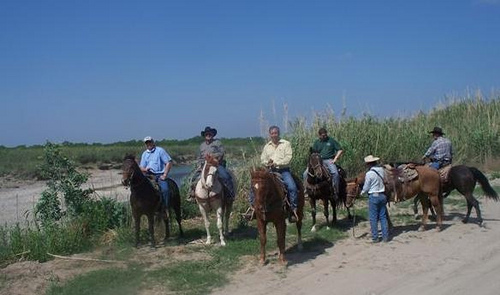Tick Riders: The Cornerstone of USDA’s Cattle Fever Tick Program
Recently I had the opportunity to travel to south Texas to learn first-hand about our Cattle Fever Tick Eradication Program.
USDA has successfully eradicated cattle fever in the U.S. Only a permanent quarantine buffer zone remains in south Texas, which spans 500 miles from Del Rio to Brownsville. The ticks and disease remain well-established in Mexico, so the buffer zone is necessary to keep U.S. cattle free of cattle fever by preventing the re-establishment of the ticks.

MRP Under Secretary Ed Avalos riding with the Tick Riders along the Rio Grande.
The USDA-employed mounted patrol officers, better known as the famous “Tick Riders,” provide the cornerstone of our surveillance program. The 86 “Tick Riders,” mounted on horseback, provide the first line of defense against an outbreak of cattle fever.
I had the opportunity and honor to ride on horseback side-by-side with some of our “Tick Riders” and Animal Plant and Health Inspection Service (APHIS) –VS Veterinarians. Following the dusty trail along the Rio Grande, south of Del Rio, I quickly experienced the enthusiasm, commitment and importance of our “Tick Riders.” That day a Mexican bull, having crossed the river, was captured.
With sore muscles as a result of the ride, I express my gratitude to these hard working public servants.

MRP Under Secretary Ed Avalos and employees at the APHIS recognition ceremony at the Amistad Pens.

Speaking about cattle ticks,did you know that in 1893 Theobald Smith, perhaps the most lauded of USDA’s early scientists made a monumental discovery that changed the course of medical research and history? Smith discovered the protozoan agent that caused Texas cattle fever and for the first time in science conclusively proved that an insect (ticks) transmitted the disease. In an auspicious beginning for the new Bureau, Smith’s paper in BAI Bulletin Number One, now called “a classic in medical literature,” for the first time decisively linked insects with the transmission of an infectious disease. Smith’s discovery preceded other discoveries of insect-carrying diseases that followed: malaria in 1897 by Ronald Ross, yellow fever in 1900 by Walter Reed and others, and typhus in 1909 by Charles Nicolle. Dr. Myron Schultz from the CDC wrote: “The discovery by Smith et al. that insects can transmit disease represents one of the fundamental steps forward that altered the entire course of medical science and public health.”